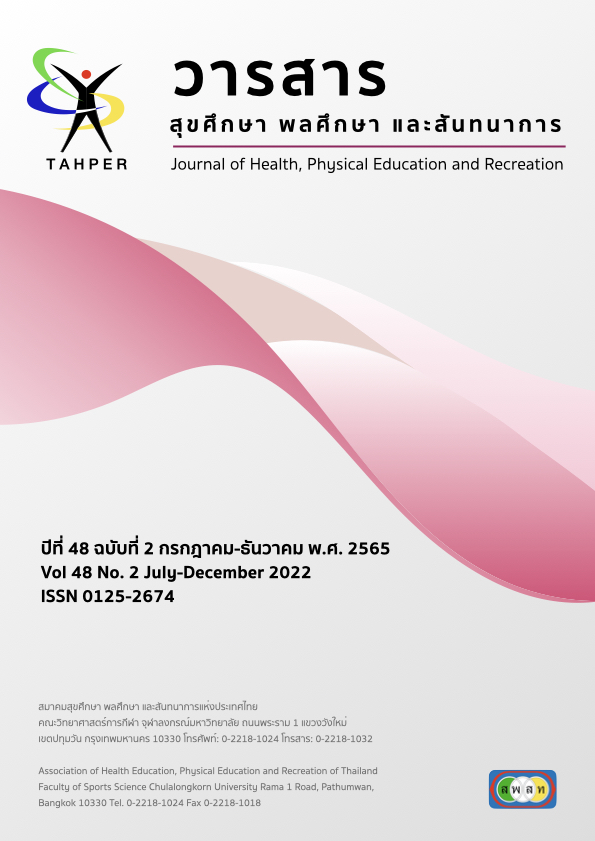ผลของการฝึกพลัยโอเมตริกที่มีต่อความเร็วในการพายเรือของนักกีฬาเรือมังกร มหาวิทยาลัยเกษตรศาสตร์ Effect of Plyometric Training on Rowing Speed of Dragon Boat Paddlers Kasetsart University
Main Article Content
Abstract
บทคัดย่อ
การวิจัยครั้งนี้มีวัตถุประสงค์ เพื่อศึกษาและเปรียบเทียบผลของโปรแกรมการฝึกพลัยโอเมตริกที่มีต่อความเร็ว ความแข็งแรง และพลังของกล้ามเนื้อ ในการพายเรือของนักกีฬาเรือมังกร มหาวิทยาลัยเกษตรศาสตร์ ภายในกลุ่ม และระหว่างกลุ่ม ของกลุ่มควบคุม และกลุ่มทดลอง ประชากรเป็นนักกีฬาเรือมังกร เพศชาย มหาวิทยาลัยเกษตรศาสตร์ ปีการศึกษา 2563 โดยเลือกแบบเจาะจง จำนวน 30 คน แบ่งออกเป็น 2 กลุ่มๆ ละ 15 คน กลุ่มควบคุม คือ กลุ่มที่ฝึกด้วยโปรแกรมการฝึกทักษะการพายเรือมังกร กลุ่มทดลอง คือ กลุ่มที่ฝึกด้วยโปรแกรมการฝึกทักษะการพายเรือมังกรควบคู่กับโปรแกรมการฝึกพลัยโอเมตริก ทำการฝึก 8 สัปดาห์ๆ ละ 3 วันๆ ละ 2 ชั่วโมง เครื่องมือวิจัย คือ โปรแกรมการฝึกทักษะการพายเรือมังกรและโปรแกรมการฝึกพลัยโอเมตริก โดยมีค่า IOC เท่ากับ 0.95 และ 0.90 ทำการทดสอบความเร็วในการพายเรือมังกรด้วยเครื่องวัดงานสำหรับกีฬาเรือมังกร ทดสอบความแข็งแรง ด้วยแบบทดสอบท่านอนดัน และทดสอบพลัง ด้วยแบบทดสอบการยืนทุ่มลูกเมดิซินบอล วิเคราะห์ข้อมูลด้วยสถิติ ค่าเฉลี่ย ส่วนเบี่ยงเบนมาตรฐาน และการทดสอบก่อนและหลังการทดลอง ภายในกลุ่ม ด้วยสถิติ T-test และ Wilcoxon signed rank test ทดสอบความแตกต่างระหว่างกลุ่ม ด้วยสถิติ Mann whitney u test
ผลการวิจัยพบว่า 1) ความเร็วในการพายเรือมังกร ความแข็งแรง และพลังของกล้ามเนื้อ ภายในกลุ่มควบคุม และกลุ่มทดลอง ก่อนการฝึก และหลังการฝึก มีความแตกต่างกันอย่างมีนัยสำคัญทางสถิติที่ระดับ .05 2) ความเร็วในการพายเรือมังกร ความแข็งแรง และพลังของกล้ามเนื้อ ระหว่างกลุ่มควบคุมและกลุ่มทดลองหลังการฝึกสัปดาห์ที่ 8 ไม่มีความแตกต่างกัน 3) ความเร็ว มีเวลาเฉลี่ยทั้งสองกลุ่มลดลง กลุ่มทดลองมีเวลาเฉลี่ยลดลงมากกว่ากลุ่มควบคุม ความแข็งแรง และพลังของกล้ามเนื้อ ของทั้งสองกลุ่มเพิ่มขึ้น
คำสำคัญ : พลัยโอเมตริก ทักษะการพายเรือมังกร ความเร็ว
Abstract
The purpose of this research was compared the control group to the experimental group of a plyometric training program on rowing speed, muscle strength, and muscle power. The target group in the study was 30 male dragon boat paddler from Kasetsart University, the academic year 2020. They were equally divided into two groups of 15 each. The control group was trained by dragon rowing training program and the experimental group was trained by both dragon rowing training program and plyometric training program. Both groups were tested for total 8 weeks, 3 days/week and 2 hours/day. Values of IOC were .95 and .90 for dragon rowing training program and plyometric training program, respectively. Rowing speed, muscle strength, and muscle power were analyzed using ergometer, bench press, and medicine ball throw, respectively. The date was statistically calculated by median, standard deviation, T-test, Wilcoxon signed-rank test, and Mann-Whitney U test.
The results demonstrated that 1) There was a statistically significant difference before and after training in both control and experimental groups (p<.05). 2) There was no statistically significant difference between control and experimental groups after 8th week of training. 3) The median of rowing speed was statistically significant decreased in both groups (p<.05). Moreover, the median of experimental group was greater than control group. In addition, the experimental group revealed the increasing of muscle strength, and muscle power
Keywords: Plyometric, Dragon boat skill, Rowing speed
Article Details

This work is licensed under a Creative Commons Attribution-NonCommercial-NoDerivatives 4.0 International License.
Critical thinking in journals is the right of the author. The Association of Health Education, Physical Education and Recreation of Thailand is not always required, to create diversity in ideas and creativity.
ความคิด ข้อวิพากษ์ในวารสารเป้นสิทธิของผู้เขียน สมาคมสุขศึกษา พลศึกษา และสันทนาการแห่งประเทศไทยไม่จำเป็นต้องเห็นชอบด้วยเสมอไป เพื่อให้เกิดความหลากหลายในความคิดและความสร้างสรรค์


